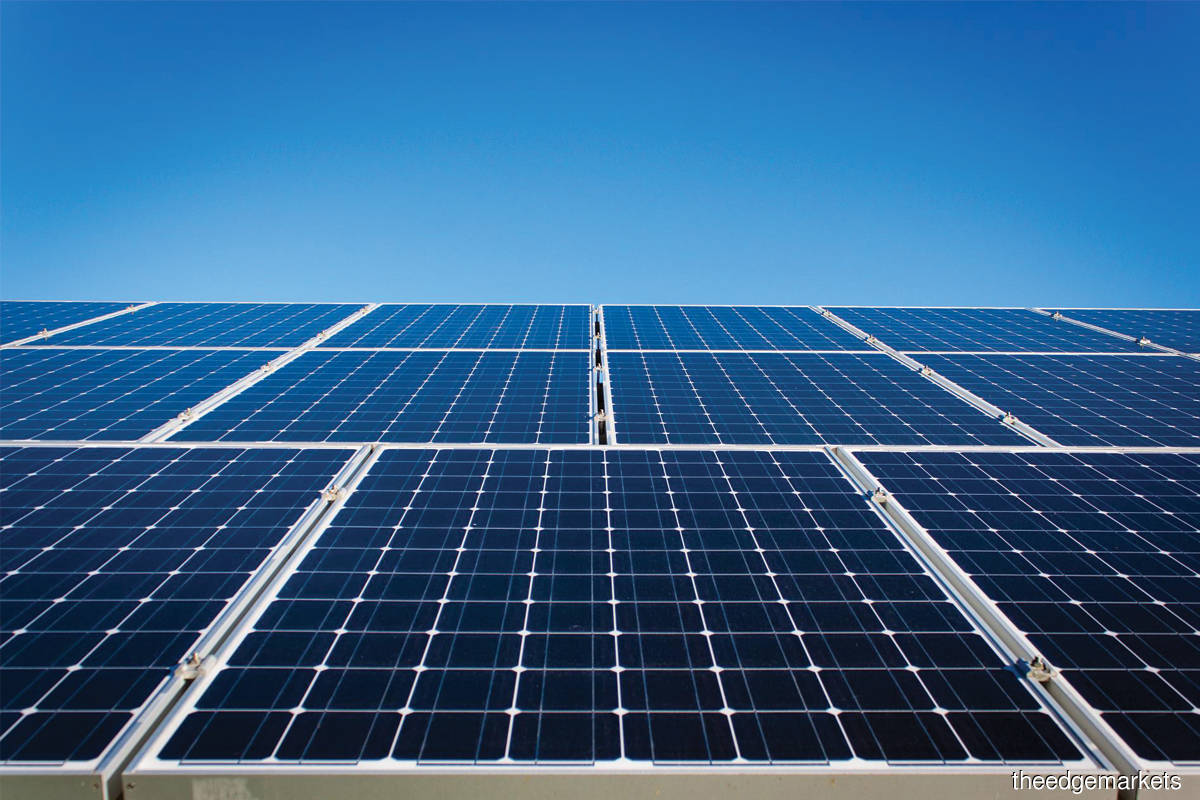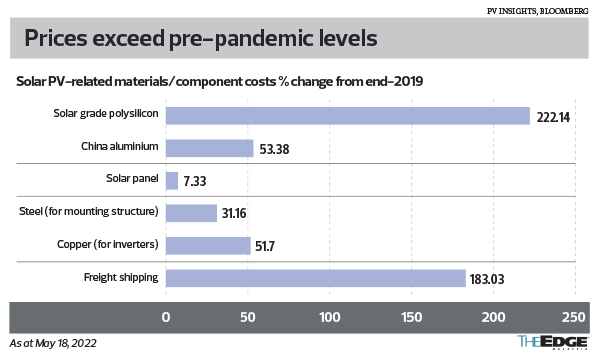Rising costs affecting LSS progress

HIGHER prices of solar panels are slowing the rollout of solar photovoltaic (PV) projects, especially large scale solar (LSS) farms with very competitive tariff bids.
From record lows in 2020, solar panel prices, which make up more than half of project costs if the land costs are excluded, had risen 30% to 40% to its three-year high in late 2021 as prices of polysilicon and aluminium jumped multifold to near decade highs.
The situation is significant enough that for certain LSS4 projects with a financial close deadline of December 2021, the government has stepped in to extend the date to March 2022.
Companies The Edge spoke to foresee some delays in project completion and slower return on investment (ROI) as a result, although most are still optimistic on uptakes moving forward, despite the persistently high prices.
Some postponements, no cancellation
Solarvest Holdings Bhd, which has some exposure in the engineering, procurement, construction and commissioning (EPCC) for LSS projects, tells The Edge it has reached mutual agreements with some customers to postpone their projects due to volatile prices.
But so far, it has not experienced any cancellations due to material price increases, it says in an email reply. “At these [price] levels, all our projects are financially feasible and need not be cancelled or reviewed at this point.”
While Samaiden Group Bhd has not experienced cancellations or postponements, it acknowledges that rising commodity prices has “primarily affected the LSS4 competitive bid projects” and impacted total project cost. Nevertheless, it says its clients are “still eager” to complete their projects, even if the ROI timeline is now longer.
“At the moment, we understand that some of the LSS4 competitive bid winners are seeking an extension of time to achieve financial close due to the materials cost increase and shortage of labour. Nonetheless, industry players are still awaiting an official response or update from the government,” it says via email.
Similarly, Pekat Group Bhd, which is more into the smaller scale commercial and industrial (C&I) segment, says it does not see cancellation of projects. Its chief financial officer Oh Keng Jin tells The Edge in an interview that project costs have risen 5% to 10%, resulting in the ROI period being extended to four to five years, from three to four years previously, for clients who paid to have their own rooftop solar assets.
There is still upside, however, considering the potential hike in electricity tariffs — which already came true this year for the non-domestic sector.
“Solar power continues to compete as a viable alternative to rising fossil fuel prices,” says Oh.
Costs being addressed
Contractors currently feel they are still able to manage or pass on rising costs.
Pekat, for one, has increased its inventory threefold to RM34.28 million from RM11.02 million a year ago to manage costs and supply disruptions.
“Further, the C&I segment has around three to four months of project turnaround from first installation. For us, we are able to pass on the costs to [our customers under new projects],” says Pekat chief operating officer Tai Yee Chee.
Likewise, Samaiden has stocked up on inventory, on top of adding a variation cost clause for longer-term LSS contracts.
“We are also enhancing our project management and execution by strengthening our supply chain management and forecasting the required purchases and stock of materials in advance, to prepare for upcoming projects.
“We also focus on project planning and the management of subcontractors to minimise the construction period, leading to greater cost savings. We believe that efficient and effective project planning and management is crucial in maintaining our competitive position at this juncture,” says Samaiden.
Solarvest has already factored in higher material costs for most of its RM762 million worth of unbilled orders to date. “For LSS4 projects due [for financial close] by 2022, we have locked in the major equipment costs at reasonable rates,” it says. It also passes on some of the cost increases to customers, while managing price fluctuations more closely in its strategic procurement.
Reservoir Link Energy Bhd, which is a main contractor for EPCC players involved in LSS projects through its solar unit Founder Energy Sdn Bhd, says it is “continuously negotiating with clients based on the current market price of materials”. “We are executing cost optimisation by reducing freight costs, sourcing for equipment from local manufacturers and/or countries closer to us,” it says in a written reply.
Prices could remain elevated
Costs are also elevated for other components, such as inverters and other electricity installations, with copper prices now 27% higher than its five-year average. Freight rates were also double their five-year average at the time of writing, while prices of steel, used for mounting structures, hovered at multi-year highs.
Moving forward, Solarvest is conservative, pointing to the Russia-Ukraine war and the lockdown in Shanghai, “which may bring [supply] chain impact and push up raw material prices again in 2H2022”.
Reservoir Link acknowledges that rising costs may have long-term implications on the profitability of solar projects, depending on how long commodity prices continue their uptrend. “Most clients are reviewing their costing. However, demand remains strong even with rising prices, as reflected in recent LSS auction participations and corporate purchasing,” it says.
Pekat thinks it is unlikely for prices to drop even further in the immediate term, despite some normalisation recently due to the “China factor”.
China, which is a key producer of solar panels, has made plans to add 75gw to 90gw of solar power this year, far higher than the 54.88gw installed in 2021. This is expected to support prices, despite the potential US tariff on Asean-produced solar panels that are manufactured by Chinese companies.
“The reality is that solar module prices were at about US$0.27/watt in 2021, from US$0.21/watt in 2020,” says Pekat chief commercial officer Wee Chee Aik. “Looking at the demand in China’s desert solar farms, demand for materials is not dropping but increasing. We don’t see prices dropping this year.”
The content is a snapshot from Publisher. Refer to the original content for accurate info. Contact us for any changes.
Related Stocks
Comments
